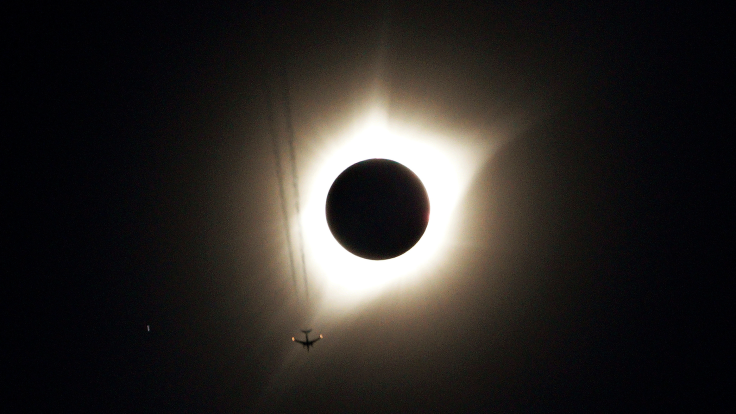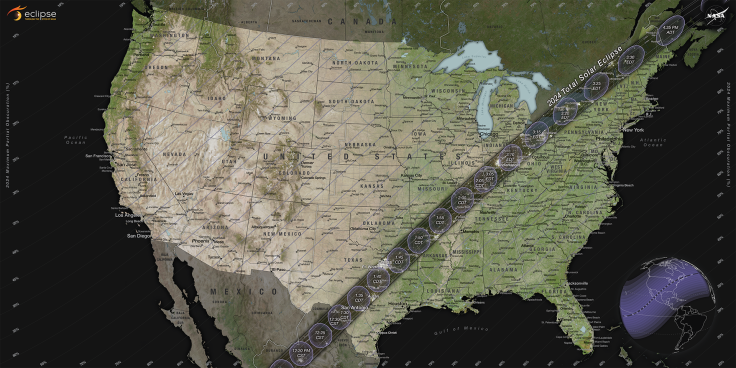Complete Guide Total Solar Eclipse 2024: Start Time, Where To See It and How It Differs From 2017
Totality will first be experienced in Mexico's Pacific coast just after 11am PDT on Apr. 8

The upcoming total solar eclipse will take place on Apr. 8, 2024 and is set to be witnessed by millions across North America.
It will be the second eclipse that the people of the United States get to witness in less than a decade, as 'The Great American Eclipse' took place on August 21, 2017.
The most recent total solar eclipse occurred on April 20, 2023, across Western Australia, Indonesia and Timor Leste.
What's special about a total solar eclipse?
The sighting of total solar eclipse is a sight to behold as it involves the Moon passing between the Sun and the Earth. This then blocks out the Sun's face and leads to the darkening of the sky, displaying what people would typically see above them at either dawn or dusk.
A total solar eclipse remains the only type of its kind that allows people to remove their eclipse glasses momentarily. This will be able to happen at the exact moment when the moon has completely covered the Sun's face, known as the totality stage of the solar eclipse.
What is also unique about the period where there is a total solar eclipse is that the Sun's outer atmosphere, the corona, becomes visible to people and those interested have a short window to examine it. The corona is unable to be properly viewed outside of a total solar eclipse as the surface beneath it is very bright.
The period of totality can cause earth's creatures to be affected, as nocturnal animals may think it is time for them to be awake and out whilst non-nocturnal animals may feel as if they are active at the wrong time and should be asleep.
How is it different from the 2017 solar eclipse?
The total solar eclipse 2024 will be an increase from the 2017 event in the width of the path of totality across the United States. Seven years ago, the path of totality ranged between 62 to 71 miles wide, and this April, it will be 108 to 122 miles in width, meaning that much more of the nation's population will be able to witness the totality occur.
The reason for this is that in 2017, the Moon was slightly further away from the Earth than it will be for the upcoming solar eclipse.
The 2024 total solar eclipse will see 31.6 million people reside within the path of totality, which more than doubles the 12 million figure from seven years prior. Even those who do not reside in the path of totality will be able to catch a glimpse of at least a portion of the eclipse, with 150 million people residing within 200 miles of the expected totality path.
There will also be a longer period of totality next month compared to the last eclipse. In 2017, Carbondale, Illinois, witnessed the longest totality period at two minutes and 42 seconds. That will increase significantly up to four minutes and 28 seconds this year, in a location roughly 25 minutes northwest of Torreon, Mexico.
When the eclipse reaches the centre of its path in Texas, the totality period will be around four minutes and 26 seconds. Those in Canada should not worry about spending little time experiencing the event as once it reaches there, it will still last up to three minutes and 21 seconds.
Also, a key difference in this year's total solar eclipse will be the magnetic field of the Sun, which will be closer to solar maximum and therefore lead to it being more active. There is a greater chance people will be able to witness eruptions from the sun compared to 2017, when the sun was nearer to solar minimum.
What time is the solar eclipse on April 8?
The total solar eclipse 2024 will first be experienced in totality across the Pacific coast of Mexico at approximately 11:07 a.m. PDT. It will travel through the U.S. and eventually exit North America at 5:16 p.m. NDT, out of the Atlantic coast of Newfoundland, Canada.
Regarding the totality timeframe across the Unites States, it will begin in Dallas, Texas at 1:40 p.m. CDT and end in Caribou, Maine at 3:34 p.m. EDT.
Where will the April eclipse be visible?
The event will be witnessed at least partially across all 48 of the contiguous U.S. states, whilst the period of totality will be visible in states including Oklahoma, Missouri, Kentucky, Indiana, Ohio, New York and New Hampshire.
Totality will be visible throughout North America, including in the Mexican states of Chihuahua, Coahuila, Nayarit, Sinaloa and Durnago. Also, the Canadian Provinces of Newfoundland, Nova Scotia, Prince Edward Island, Ontario, Quebec and New Brunswick will experience the period of totality.

Where can I watch the eclipse?
If you are not lucky enough to witness April's eclipse in person across North America, you can view the event through various livestream feeds on YouTube on the day of the event. Reliable channels that are confirmed to cover the event include NASA TV, Exploratorium, Discovery Channel, Slooh and timeanddate.
For people in the U.S., they can attend special events to watch NASA TV's, such as at the Kerrville Eclipse Festival, the Indianapolis Motor Speedway, the Total Eclipse Fest 2024 in Ohio as well as the Southern Illinois Crossroads Eclipse Festival.
When will the next solar eclipse happen?
After April's total solar eclipse, the next one will occur on Aug. 12, 2026, and will be visible in some capacity across most of Europe and North America. The total eclipse will be visible when it passes across northern Spain, Iceland, the Atlantic Ocean, the Arctic and Greenland.
What kind of glasses are needed for the eclipse?
To experience the total solar eclipse, you must wear safe solar viewing glasses or have a handheld solar viewer for most of the event and make sure the lens is not scratched, torn or damaged. Not having specialised viewing glasses when staring at the sun can lead to serious eye injuries, with regular sunglasses not a safe option.
During the time where the Sun is completely blocked out by the Moon, those in attendance can remove their viewing glasses or solar viewers and witness the totality period. The moment the Sun begins to reappear, the eclipse glasses must be put back on instantly.
© Copyright IBTimes 2024. All rights reserved.







